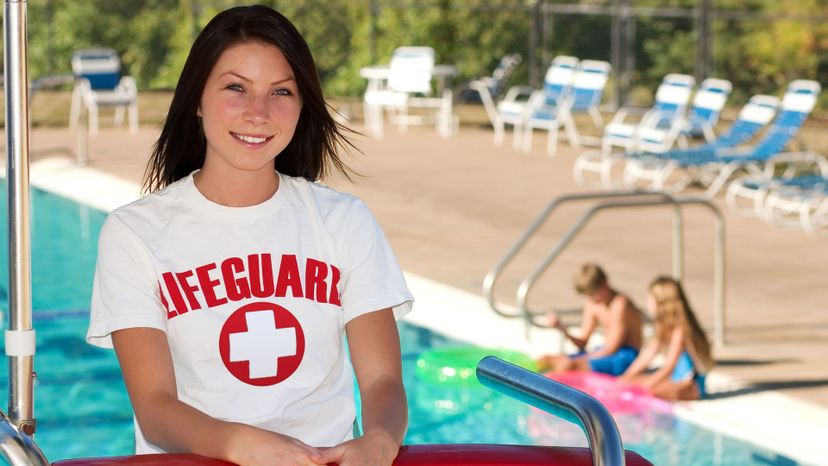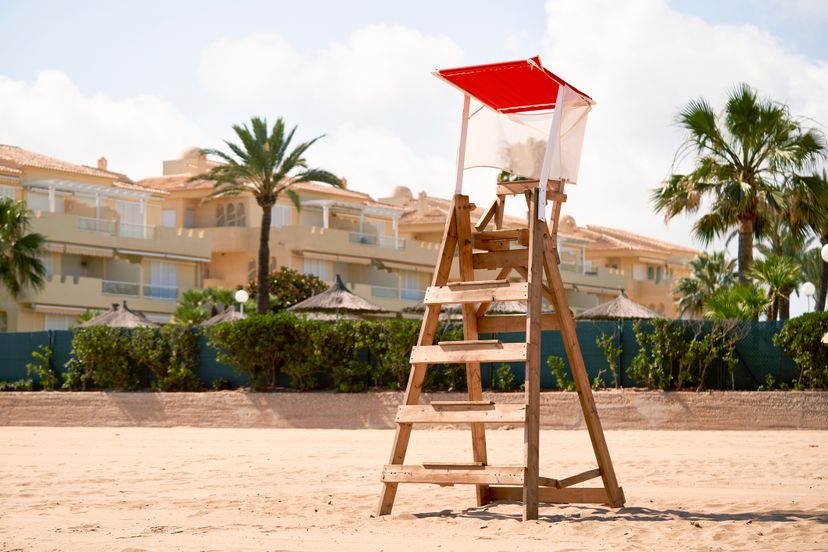
About This Quiz
"Are you ready to put your lifeguard practice test? Dive into this fun and informative quiz that covers everything from jumps to CPR techniques. Lifeguards play a crucial role in saving lives, and this quiz will challenge your understanding of their skills and techniques. Whether you're an aspiring lifeguard or just curious about what it takes to keep swimmers safe, this quiz is for you!
From different types of jumps to whistle blasts and first aid treatment, this quiz covers it all. Can you identify the best entry method for a potential spinal injury rescue? Do you know how many whistle blasts signal a water emergency? Test your knowledge and see if you can score at least a 75% on this Lifeguard Knowledge Quiz. Get ready to make a splash and show off your lifeguard expertise!
So, what are you waiting for? Take a break from the poolside and challenge yourself with this engaging quiz. With 35 questions to tackle, you'll have plenty of opportunities to showcase your lifeguard knowledge. Don't forget to brush up on your CPR techniques and practice your whistle blasts. Let's see if you have what it takes to ace the Lifeguard Knowledge Quiz by Talin Vartanian!
"The answer is one short whistle blast. A lifeguard will use this to get someone's attention for minor situations like running by the pool or diving into a shallow area of the water.
Lifeguards don't typically use a bicycle in a beach setting, as it would be difficult to actually ride a bike through sand. Instead, they use vehicles like inflatable boats (in the ocean), quad bikes and pick-up trucks.
The 10:20 rule is an important technique that is used by lifeguards in both swimming pool and beach settings. It's when a lifeguard scans the entirety of the swimming area for 10 seconds and is within a 20-second reach of all swimmers.
Advertisement
Everybody should clear the pool when a lifeguard blows the whistle with one long breath. This doesn't necessarily mean an emergency, either; it could simply be a drill.
A run-and-swim entry involves a lifeguard running through shallow waters to save someone. This is entry is used when the water is typically no more than 3 feet deep.
If the victim has a possible injury of the neck or spine, a lifeguard will typically use a slide-in entry. This is when a lifeguard slowly slides into the pool without causing any disturbances in the water, as that could affect the potential injury even more.
Advertisement
An active-victim rescue involves a lifeguard saving a conscious person, or someone who shows active signs of needing help in the water. This is opposite from a passive-victim rescue, when the victim may be unconscious.
An AED is a device used to reset a victim's heart rhythm by using two pads on specific areas of the torso. AED stands for "automated external defibrillator."

Lifeguards should not talk to other lifeguards, as this can create a distraction from a potential victim. A lifeguard's primary duties are to clean the pool area, provide first aid for minor injuries, scanning the swimming area and performing rescue operations.
Advertisement
The answer is two short whistle blows. This is used to alert other lifeguards to a potential emergency situation. If a lifeguard needs to leave his or her station to respond to an emergency or perform a rescue, the two short whistle blasts will let other lifeguards know that backup help might be needed.
A passive-victim rescue involves saving a victim who may be unconscious or showing unusual signs of drowning. This is different from an active-victim rescue, in which the victim is conscious.
A stride jump is done from the edge of a pool, when the lifeguard extends one leg forward during the jump, like taking a stride when walking. This entry is typically used when the water is at least 5 feet deep.
Advertisement
A compact jump involves lightly tucking in the knees and jumping from a high point, like a lifeguard chair. The water should be at least 5 feet deep for this type of jump.
If a victim is near the edge of a pool and shows signs of distress, a lifeguard can simply pull the person out of the water by reaching out to assist them, perhaps with the help of a rescue tube or a rescue pole.
A simple assist is used in shallow waters. This could include helping a victim regain their balance in shallow waters or rescuing a submerged victim who is near the edge of the pool.
Advertisement
If a victim is facing away from you as they are drowning, an active victim rear rescue should be performed. In this approach, the lifeguard will grasp the victim under the arms from behind, supporting the victim's shoulders while kicking and pulling them back towards the shore or the side of the pool.
This technique is called a beach drag. It's typically used in a beach setting to gently pull a victim out of the water and to a safe location. This method shouldn't be used if the victim might have a back, head or neck injury, as being pulled along the ground could cause worse damage.
The answer is three short whistle blows. This is used to indicate that a lifeguard is about to perform a rescue operation.
Advertisement
A walking assist is used to help a victim walk from the water and to a safe location. This is done by placing the arm of the victim around the lifeguard's shoulders for support.
Two lifeguards are needed to complete a front-and-back carry. The first lifeguard holds the legs of the victim, while the second lifeguard offers support to the torso area. This method is used to carry a person who's unconscious or unable to move out of shallow water.
A variety of techniques are used to open a victim's airway, but a spinal maneuver is not one of them. The other three techniques in the answer list are used to open the airway to allow for oxygen flow into the victim.
Advertisement
A spinal board is used for spinal rescues, which may indicate a potential head, neck or spinal injury. This type of rescue also works in both shallow waters and deep waters.
An AED is not a type of oxygen delivery device. Instead, it's used to reset the heart rhythm of a victim with a life-threatening irregular heartbeat. The rest of answers in the list are in fact oxygen delivery devices.
30:2 is a rule-of-thumb technique that is used to perform efficient CPR on a victim whose heart has stopped beating. It consists of a pattern of 30 chest compressions followed by 2 rescue breaths.
Advertisement
The range of chest compressions that should be administered over a 1-minute span is 100-120. This is accomplished via the 30:2 rule, which consists of 30 chest compressions, followed by 2 rescue breaths (this cycle is repeated).
Two long whistle blows are used to clear the pool due to an emergency. This may also be used to signal swimmers that the pool is now closed.
A lifeguard should spend no more than 10 seconds when checking the victim's pulse. A lifeguard must work quickly in emergency situations, and too much time spent on checking for a pulse may delay required treatment to a victim.
Advertisement
H.A.IN.E.S stands for "High arm in endangered spine." It's a type of position in which a victim is turned to his or her side so that the spine is not potentially damaged. It also keeps the airway open.
Jaundice refers to a yellow color in the white part of a person's eyeball and the skin. Jaundice can be caused by a number of different underlying medical conditions, but it is not a sign of respiratory distress. A lifeguard should look for sweating, abnormal breathing, dizziness and a blue color around the lips to detect if someone is in respiratory distress.
Five back blows should be performed by a lifeguard to a victim that is actively choking. This may be followed by five abdominal thrusts.
Advertisement
A bag-valve mask, or BVM, should be used for a victim who has severe hypoxia, which is when the body is severely lacking oxygen. Also called a manual resuscitator or self-inflating bag, works by forcing air into the lungs and providing ventilation. A non-rebreather mask may also be used.
The 'P' in SAMPLE stands for "past medical history. S = symptoms, A = allergies, M = medications, P = past medical history, L = last oral intake and E = events (which led to the current situation).
The nostrils should be pinched together by the victim to stop a nose bleed. Lifeguards can also utilize an ice pack on the nose as well.
Advertisement
An elastic roller bandage should be applied to the affected area. This type of bandage reduces blood flow and can help prevent swelling. Of course, if it's possible the snake was venomous, expert medical care should also be sought immediately. The rest of the answers in the list should never be used for a snakebite.
A rescue tube is used for various rescue operations. It is bright red in color and held in a horizontal position, across the lifeguard's waist.